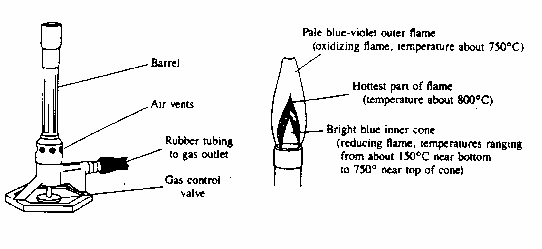
25
D.
Heating Samples
1.
Hot Plates
Hot plates will generally be used as the
heat source in this laboratory. A setting of 3-4 on most
hot plates is sufficient to heat the solution
quickly. NEVER turn the hot plate to “high” because
of the danger of burning the sample and
yourself.
2.
Bunsen Burners
On occasion you will be required to use
the gas flame from a Bunsen burner to heat a sample
intensely. Because of the inherent
dangers of using an open flame, it is very important that you
understand how to use a Bunsen burner
properly.
The first illustration shows the Bunsen
burner, the second shows the structure of a good flame.
Gas and air are mixed in the barrel and
burn as they emerge at the top. Both the flow of gas
and air can be controlled by valve arrangements
at the base of the Bunsen burner. Your
laboratory instructor will demonstrate
the use of these metering arrangements. The inlet for the
gas is the screw valve in the centre of
the base of the burner and the air inlets are the holes at
the bottom of the barrel. If you
increase the flow of gas, the flame will rapidly become larger,
change from blue to yellow and wave in
any breeze or current of air. If you increase the flow
of air by further opening the air vents,
the flame will get smaller, change from yellow to blue
and begin to roar.
If you cannot get the burner to light,
immediately turn off the gas and
consult your laboratory instructor.
Once your laboratory instructor has demonstrated
the lighting and use of a Bunsen burner, prepare
to light your burner in the following
manner.
